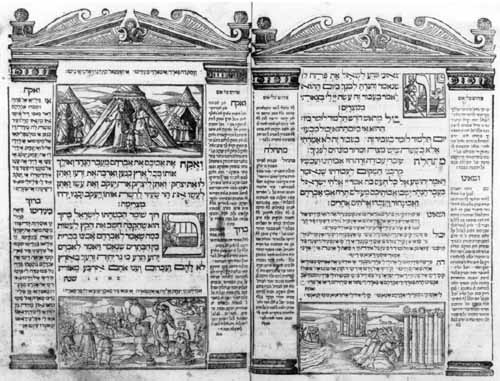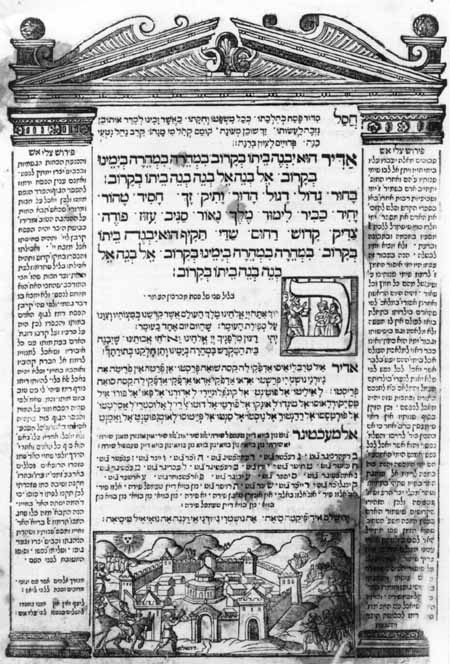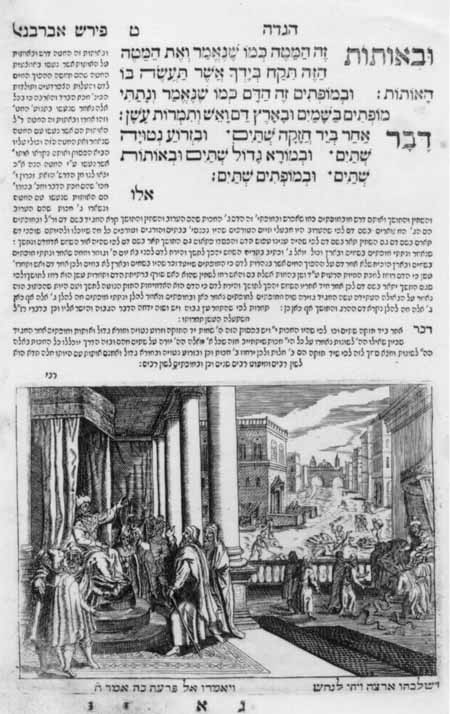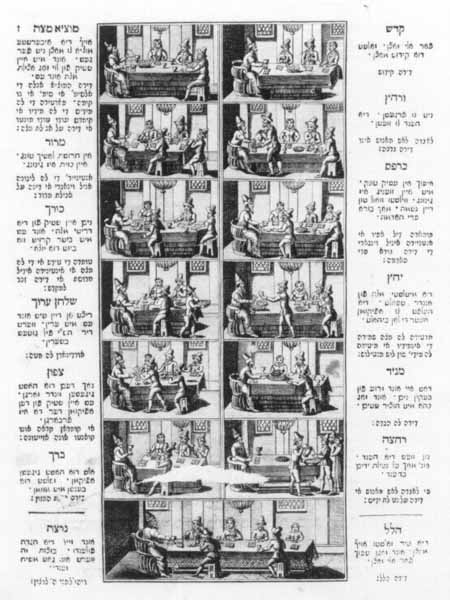Adding Beauty to Holiness: Illustrated Haggadot
The illuminated Haggadah manuscripts paved the way for unending editions of illustrated Haggadot which continue to the present day. From the Library's impressive collection of Haggadot, we choose seven. Four illustrate the ongoing influence of early and late seventeenth- century editions; three are pictorial departures which appeared once and were never copied.
In 1609, a Haggadah of singular beauty was published in Venice by Israel ben David Zifroni, a veteran printer and copy editor of Hebrew books in Italy and Switzerland. Each page is framed by an artistically wrought border. Woodcut illustrations of the Passover ritual and the contents of the Haggadah abound, as well as depictions of Moses, Aaron, Kings David and Solomon, and miniature vignettes framed by the large initial letters. What is most rewarding to the student of history are illustrations of contemporary preparations for the holiday, including the baking of matzoh. This Haggadah appeared in three versions, with translations and instructions in Judeo-German (Yiddish), Judeo-Italian, and Judeo-Spanish (Ladino), all printed in Hebrew letters. A second printing appeared in 1629, with a new title page extolling the beauty of the illustrations and announcing the inclusion of a commentary Tseli Esh (Roasted in Fire), an abridgement by Leone da Modena of Isaac Abrabanel's Zebah Pesah (Passover Sacrifice), because
It already includes illustrations to delight the eye, how much better it now is to add explanations which will delight the "spiritual eye" [the soul].
 |
The edition was commissioned by Moses ben Gershon Parenzo, the last of three generations of Hebrew printers, and issued by the Bragadini press. The Library's crisp copies of this edition and one published in 1740 display the durability and popularity of those illustrations by an artist whose name is unknown but whose creations continued to beautify Haggadot published in the nineteenth and the twentieth centuries, as for example, in a 1904 Livorno edition with an Arabic translation for Tunisian Jews.
 |
The illustrations most widely copied in illuminated manuscripts (e.g., the exact copy by the artist-scribe Ya'akov ben Yehudah Leib, written in Hamburg in 1728) and in hundreds of printed editions are those which first appeared in a lavishly illustrated and beautifully printed Haggadah published in Amsterdam in 1695. For the first time in any edition of a Haggadah, the illustrator is identified, Abraham bar Jacob "of the family of Abraham our Father," i.e., a proselyte to Judaism. For the first time, too, the illustrations are copper engravings rather than the woodcuts of earlier editions. Engraving made possible more richly detailed delineations, and these were copies or adaptations of biblical engravings by the Swiss artist Mattaeus Merian, which were first published in 1625-30. The simple son is copied from Merian's depiction of Saul as he was being anointed by the Prophet Samuel. The shepherd's crook held by Saul is changed into a staff, and the person portrayed is "Judaized" by placing a hat on what was, in Merian's depiction, a bald head. The look of the simple country bumpkin is retained. The most dramatic depictions are of the Children of Israel leaving Egypt and standing at Mt. Sinai, Moses descending from the mountain, a Tablet of the Law in each hand, and Aaron waiting below, surrounded by tents and people in Oriental and medieval garb.
 |
The Library's fine copy contains the inserted map, previously described, which is missing in many copies, no doubt removed for framing by devotees of cartography. It is perhaps ironic that illustrations which for over two centuries have been the most widely reproduced (e.g., the crude copies in the Furth, 1755 edition; or the perfected engravings in the Vienna, 1823 printing) -which for almost three centuries have been viewed as the most authentic Haggadah depictions-stem from biblical scenes drawn by a Christian.
 |
Sources: Abraham J. Karp, From the Ends of the Earth: Judaic Treasures of the Library of Congress, (DC: Library of Congress, 1991).


